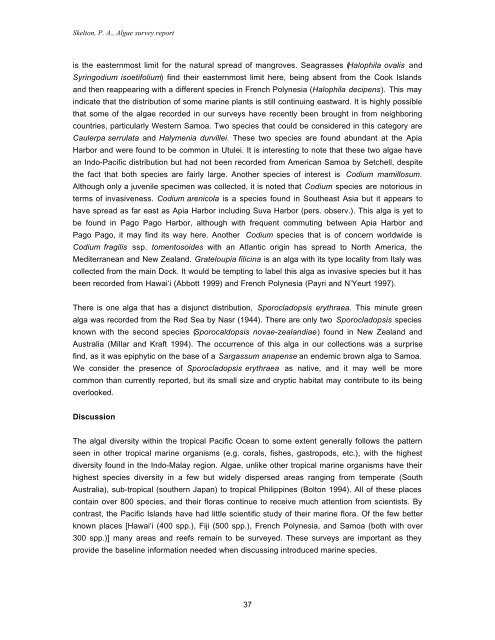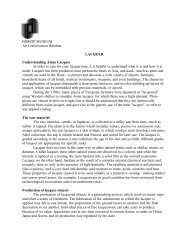INTRODUCED MARINE SPECIES IN PAGO ... - Bishop Museum
INTRODUCED MARINE SPECIES IN PAGO ... - Bishop Museum
INTRODUCED MARINE SPECIES IN PAGO ... - Bishop Museum
You also want an ePaper? Increase the reach of your titles
YUMPU automatically turns print PDFs into web optimized ePapers that Google loves.
Skelton, P. A., Algae survey report<br />
is the easternmost limit for the natural spread of mangroves. Seagrasses (Halophila ovalis and<br />
Syringodium isoetifolium) find their easternmost limit here, being absent from the Cook Islands<br />
and then reappearing with a different species in French Polynesia (Halophila decipens). This may<br />
indicate that the distribution of some marine plants is still continuing eastward. It is highly possible<br />
that some of the algae recorded in our surveys have recently been brought in from neighboring<br />
countries, particularly Western Samoa. Two species that could be considered in this category are<br />
Caulerpa serrulata and Halymenia durvillei. These two species are found abundant at the Apia<br />
Harbor and were found to be common in Utulei. It is interesting to note that these two algae have<br />
an Indo-Pacific distribution but had not been recorded from American Samoa by Setchell, despite<br />
the fact that both species are fairly large. Another species of interest is Codium mamillosum.<br />
Although only a juvenile specimen was collected, it is noted that Codium species are notorious in<br />
terms of invasiveness. Codium arenicola is a species found in Southeast Asia but it appears to<br />
have spread as far east as Apia Harbor including Suva Harbor (pers. observ.). This alga is yet to<br />
be found in Pago Pago Harbor, although with frequent commuting between Apia Harbor and<br />
Pago Pago, it may find its way here. Another Codium species that is of concern worldwide is<br />
Codium fragilis ssp. tomentosoides with an Atlantic origin has spread to North America, the<br />
Mediterranean and New Zealand. Grateloupia filicina is an alga with its type locality from Italy was<br />
collected from the main Dock. It would be tempting to label this alga as invasive species but it has<br />
been recorded from Hawai‘i (Abbott 1999) and French Polynesia (Payri and N’Yeurt 1997).<br />
There is one alga that has a disjunct distribution, Sporocladopsis erythraea. This minute green<br />
alga was recorded from the Red Sea by Nasr (1944). There are only two Sporocladopsis species<br />
known with the second species (Sporocaldopsis novae-zealandiae) found in New Zealand and<br />
Australia (Millar and Kraft 1994). The occurrence of this alga in our collections was a surprise<br />
find, as it was epiphytic on the base of a Sargassum anapense an endemic brown alga to Samoa.<br />
We consider the presence of Sporocladopsis erythraea as native, and it may well be more<br />
common than currently reported, but its small size and cryptic habitat may contribute to its being<br />
overlooked.<br />
Discussion<br />
The algal diversity within the tropical Pacific Ocean to some extent generally follows the pattern<br />
seen in other tropical marine organisms (e.g. corals, fishes, gastropods, etc.), with the highest<br />
diversity found in the Indo-Malay region. Algae, unlike other tropical marine organisms have their<br />
highest species diversity in a few but widely dispersed areas ranging from temperate (South<br />
Australia), sub-tropical (southern Japan) to tropical Philippines (Bolton 1994). All of these places<br />
contain over 800 species, and their floras continue to receive much attention from scientists. By<br />
contrast, the Pacific Islands have had little scientific study of their marine flora. Of the few better<br />
known places [Hawai‘i (400 spp.), Fiji (500 spp.), French Polynesia, and Samoa (both with over<br />
300 spp.)] many areas and reefs remain to be surveyed. These surveys are important as they<br />
provide the baseline information needed when discussing introduced marine species.<br />
37






